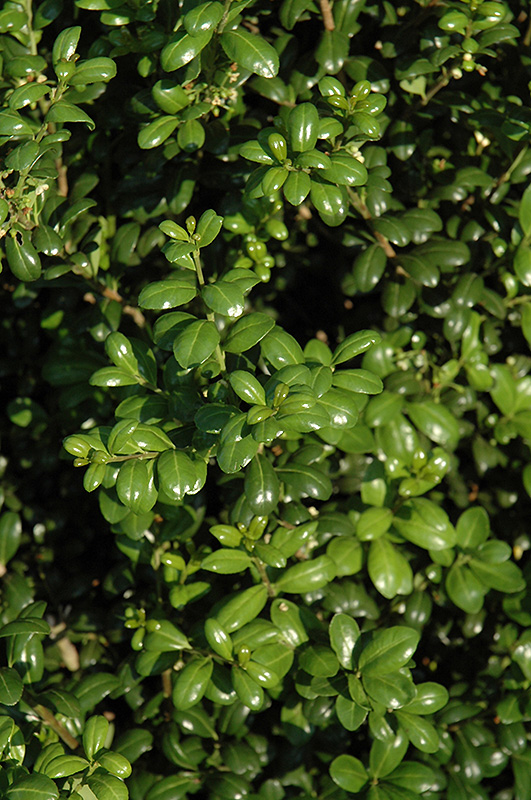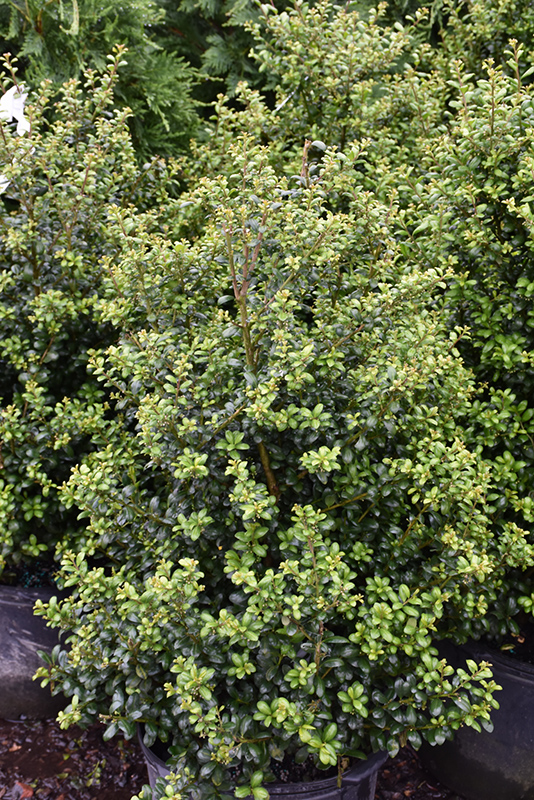Height: 8 feet Spread: 6 feet
Sunlight:
Hardiness Zone: 5b Other Names: Box-leaved Holly Description: Valued for its lustrous black berries and attractive evergreen foliage during the winter; its conical, compact growth habit makes it perfect for smaller landscapes; can be sheared for a formal appearance Ornamental Features Chesapeake Japanese Holly is primarily grown for its highly ornamental fruit. It features an abundance of magnificent black berries in mid fall. It has attractive dark green evergreen foliage. The small glossy oval leaves are highly ornamental and remain dark green throughout the winter. Landscape Attributes Chesapeake Japanese Holly is a dense multi-stemmed evergreen shrub with a distinctive and refined pyramidal form. Its relatively fine texture sets it apart from other landscape plants with less refined foliage. This is a relatively low maintenance shrub, and is best pruned in late winter once the threat of extreme cold has passed. It is a good choice for attracting birds and bees to your yard. It has no significant negative characteristics. Chesapeake Japanese Holly is recommended for the following landscape applications; Planting & Growing Chesapeake Japanese Holly will grow to be about 8 feet tall at maturity, with a spread of 6 feet. It has a low canopy with a typical clearance of 1 foot from the ground, and is suitable for planting under power lines. It grows at a medium rate, and under ideal conditions can be expected to live for 50 years or more. This shrub does best in full sun to partial shade. It prefers to grow in moist to wet soil, and will even tolerate some standing water. It is particular about its soil conditions, with a strong preference for rich, acidic soils. It is quite intolerant of urban pollution, therefore inner city or urban streetside plantings are best avoided, and will benefit from being planted in a relatively sheltered location. Consider applying a thick mulch around the root zone in winter to protect it in exposed locations or colder microclimates. This is a selected variety of a species not originally from North America.![]()
![]()
![]()
![]()
![]()
![]()
![]()
![]()
![]()
![]()
![]()
![]()
![]()
![]()
![]()
![]()
martha@rainfrostnursery.com
| 2452 Bethel Church Rd, Forest, VA 24551
Call us Today! (434) 525-3107
NetPS
Plant Finder
Characteristics
Applications
Features & Attributes
Phone:
(434) 525-3107 |
Email:
martha@rainfrostnursery.com |
Fax: 434-525-2062
Address: 2452 Bethel Church Rd, Forest, VA 24551
Business Hours:
Retail Nursery Hours are 9 to 5 Monday through Sat. | Closed Sundays




Content, including images, displayed on this website is protected by copyright laws. Downloading, republication, retransmission or reproduction of content on this website is strictly prohibited. Terms of Use
| Privacy Policy



